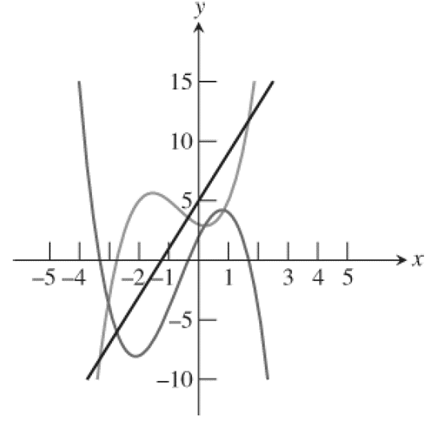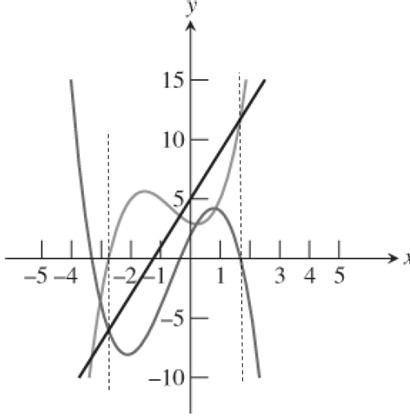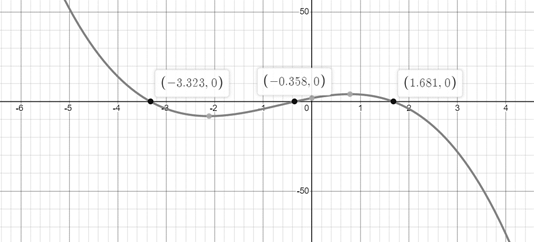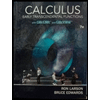
Concept explainers
a)
To write: An equation that can be solved to find the points of intersection of the graphs of y1 and y2 .
An equation that can be solved to find the points of intersection of the graphs of y1 and y2 is −x3−2x2+5x+2=0
Given Information:
The equations y1=4x+5 , y2=x3+2x2−x+3 and y3=−x3−2x2+5x+2 .
Concept Used:
The points of intersection of graphs of y1 and y2 are the values of x where y1=y2 .
Calculation:
Equate y1=4x+5 to y2=x3+2x2−x+3 and simplify.
y1=y24x+5=x3+2x2−x+3x3+2x2−x+3−4x−5=0x3+2x2−5x−2=0−x3−2x2+5x+2=0
Therefore, −x3−2x2+5x+2=0 is an equation that can be solved to find the points of intersection of the graphs of y1 and y2 .
b)
To find: Write an equation that can be solved to find the x -intercepts of the graph of y .
The required equation is −x3−2x2+5x+2=0 .
Given Information:
The equation y3=−x3−2x2+5x+2 .
Concept Used:
The intercept for any equation is found by equation it to 0.
Calculation:
Equate y3 to 0.
y3=0−x3−2x2+5x+2=0
Therefore, the required equation is −x3−2x2+5x+2=0 .
c)
To explain: How does the graphical model reflect the fact that the answers to (a) and (b) are equivalent algebraically.
Given Information:
The equations y1=4x+5 , y2=x3+2x2−x+3 , y3=−x3−2x2+5x+2 and the graph shown in figure 1.

Figure 1
Explanation:
Draw the vertical lines at the points of intersection of y1 and y2 as shown in figure 2.

Figure 2
From figure 2 it follows that the value of x at which the graphs of y1 and y2 intersects are the x -intercepts of the graph of y3=−x3−2x2+5x+2 .
Also, the equation for finding the intersection points of y1 and y2 is same equation that can be used to find the x -intercepts y3=−x3−2x2+5x+2 .
Therefore, the graphical model reflects the fact that the answers to (a) and (b) are equivalent algebraically.
d)
To check: Numerically that the x -intercepts of y3=−x3−2x2+5x+2 give the same values when substituted into the expressions for and y1 and y2 .
Given Information:
The equations y1=4x+5 , y2=x3+2x2−x+3 and y3=−x3−2x2+5x+2 .
Calculation:
The equation −x3−2x2+5x+2=0 gives the x -intercepts of the graph of y3 .
The graph of −x3−2x2+5x+2 is shown in figure 3.

Figure 3
Thus, the real solutions of −x3−2x2+5x+2=0 are −3.323 , −0.358 and 1.681 .
Now, substitute x=−3.323 , x=−0.358 and x=1.681 into y2=x3+2x2−x+3 as follows.
y1(−3.323)=4(−3.323)+5=−8.292y1(−0.358)=4(−0.358)+5=3.568y1(1.681)=4(1.681)+5=11.724
Now, substitute x=−3.323 , x=−0.358 and x=1.681 into y1=4x+5 as follows. y2(−3.323)=(−3.323)3+2(−3.323)2−(−3.323)+3=−8.286y2(−0.358)=(−0.358)3+2(−0.358)2−(−0.358)+3=−3.568y2(1.681)=(1.681)3+2(1.681)2−(1.681)+3=11.721
Thus, y1=y2 at the points −3.323 , −0.358 and 1.681 .
Therefore, it follows that the intercepts of y3=−x3−2x2+5x+2 aret the points of intersection of y1 and y2 .
Chapter 1 Solutions
PRECALCULUS:...COMMON CORE ED.-W/ACCESS
- quick solve thisarrow_forwardquick solve thisarrow_forwardThis table displays the current in equal intervals. Time t/ms 05 10 15 20 25 30 Current i/A 0 4.8 9.1 12.7 8.8 3.5 0 The formula for the charge as follows: 30x10-3 q 0 i dt Use formula to solve the current at 30ms using both the trapezoidal rule and Simpson's rule showing all steps and workingarrow_forward
 Calculus: Early TranscendentalsCalculusISBN:9781285741550Author:James StewartPublisher:Cengage Learning
Calculus: Early TranscendentalsCalculusISBN:9781285741550Author:James StewartPublisher:Cengage Learning Thomas' Calculus (14th Edition)CalculusISBN:9780134438986Author:Joel R. Hass, Christopher E. Heil, Maurice D. WeirPublisher:PEARSON
Thomas' Calculus (14th Edition)CalculusISBN:9780134438986Author:Joel R. Hass, Christopher E. Heil, Maurice D. WeirPublisher:PEARSON Calculus: Early Transcendentals (3rd Edition)CalculusISBN:9780134763644Author:William L. Briggs, Lyle Cochran, Bernard Gillett, Eric SchulzPublisher:PEARSON
Calculus: Early Transcendentals (3rd Edition)CalculusISBN:9780134763644Author:William L. Briggs, Lyle Cochran, Bernard Gillett, Eric SchulzPublisher:PEARSON Calculus: Early TranscendentalsCalculusISBN:9781319050740Author:Jon Rogawski, Colin Adams, Robert FranzosaPublisher:W. H. Freeman
Calculus: Early TranscendentalsCalculusISBN:9781319050740Author:Jon Rogawski, Colin Adams, Robert FranzosaPublisher:W. H. Freeman
 Calculus: Early Transcendental FunctionsCalculusISBN:9781337552516Author:Ron Larson, Bruce H. EdwardsPublisher:Cengage Learning
Calculus: Early Transcendental FunctionsCalculusISBN:9781337552516Author:Ron Larson, Bruce H. EdwardsPublisher:Cengage Learning





